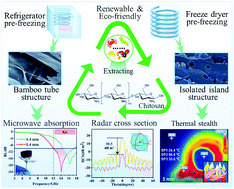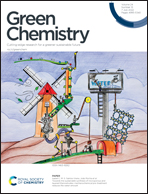Morphology control of eco-friendly chitosan-derived carbon aerogels for efficient microwave absorption at thin thickness and thermal stealth†
Abstract
In the face of increasingly severe electromagnetic wave (EMW) pollution, the research of biomass-based carbon materials due to the advantages of being green, renewable, environment-friendly, porous and light has become one of the most attractive topics. However, there is little research on the microstructure control of biomass-based materials. Herein, two kinds of chitosan-derived carbon aerogels (CAs) were prepared by adjusting the amount of chitosan and changing the pre-freezing method. Two morphologies of bamboo tube structure (BTS) and isolated island structure (IIS) were controlled by the growth speed and direction of ice crystals in a refrigerator and freeze dryer differently. The obtained samples with very low densities of 0.075–0.174 g cm−3 can bear 400 times their own weight. Furthermore, the unique layer spacing and porous characteristics make the infrared emissivity of IIS aerogels possess 0.545–0.709 at 20–300 °C with greater thermal insulation. In particular, the effective absorption bandwidth (EAB) of the IIS aerogel nearly contains the entire Ku band within the thickness of 1.0–1.4 mm, and the minimum reflection loss (RLmin) peaks appear to shift to the left compared with the IIS aerogel. Besides, the simulation results of radar cross-section (RCS) show that the IIS with a thickness of 1.4 mm can reduce the RCS by ∼20.3 dB m2 at 14.1 GHz. This study provides a reference for the study of eco-friendly chitosan-derived carbon absorbers.



 Please wait while we load your content...
Please wait while we load your content...